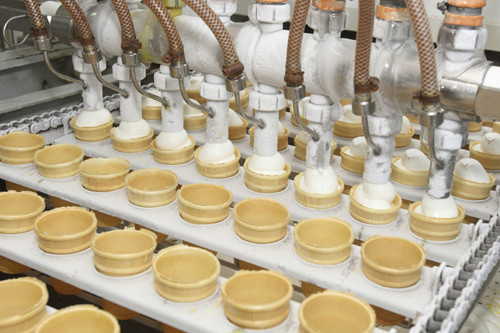
Where physics meets food: preparation of ice-cream in a factory. (Courtesy: iStockphoto/Leonid Shcheglov)
By Matin Durrani
As Physics World editor, I spend most of my time covering science that I have never been involved in. I might write articles about astrophysicists, interview atomic physicists or edit features by particle physicists, but it doesn’t mean I’ve ever done any research in those fields.
It was therefore a pleasant change last Friday to attend a summit organized by the Institute of Physics, which publishes Physics World, on physics in food manufacturing. Back in the 1990s, I did a PhD with Athene Donald at the Cavendish Laboratory in Cambridge on the physical properties of mixtures of gel-forming biopolymers – materials that apart from being interesting from a fundamental point of view are also relevant to the food industry.
Many foods, after all, are complex, multicomponent mixtures – and if you can understand how they behave, then you can create foods that are healthier, cheaper and perhaps even tastier too.
There was a certain amount of disdain, though, among some of my colleagues at the Cavendish for what our group was doing. Food? That’s not physics! “Real” physicists should be doing something much more serious – ideally particle physics (preferably theoretical); condensed-matter physics at a push. Soft condensed-matter (polymers, colloids, liquid crystals) was at the bottom of the pecking order, with anything food-related off the scale.
Times have changed and physics departments are now keener than ever to show that their research has – that dreaded word – “impact”. After all, a department needs research income to survive and money from industrial sponsors is welcomed with open arms. Well, there’s nothing more relevant to the wider world than what we eat.
In fact, I wish back at the start of my PhD that I’d heard the talk given at last week’s meeting by Peter Lilford, a former senior researcher at food-giant Unilever.
Lilford put the field of “food physics” in context, outlining the challenges of doing research in the area. Much of the food industry, he explained, is based on physical processing – doing things to materials at different temperatures, pressures and flow rates – but it’s still largely governed by empiricism. “We need all the physics we can get,” he told delegates.
He then began (but didn’t finish) a lovely anecdote about a plan back in the day to improve the productivity of a soup-manufacturing line by simply increasing the size of the cooking vats and installing bigger heaters. Sounds simple but it isn’t: the thermodynamics of heating multiphase liquids (water and bits of vegetable) is complicated and I doubt the profit from a production line scales linearly with size of a vat.
It’s the kind of question, though, that physicists are good at tackling. In fact, one theme that emerged from the meeting is that academic physicists absolutely want these kinds of hard problems, not easy ones, and that industrial researchers are similarly keen on challenges that will take academics a long time to solve. So, you want a tough challenge? Then try the physics of food.
Just think about ice cream – it’s a complex, multicomponent structure that has to withstand a range of temperatures from cold-storage warehouses to supermarket freezer cabinets. It’s subject to the most stringent product-testing environment of them all: your mouth. Oh, and can you try and make it as healthy as possible because there’s an obesity crisis in the West.
The summit was designed to bring together researchers from industry and academia to identify “pre-competitive” problems that companies can work on collectively and openly for the benefit of the entire sector. It’s natural for businesses to focus on their own problems in isolation but sometimes it helps to join forces with rivals. Among the delegates were researchers from the likes of PepsiCo, Unilever, Nestle and Jacob-Douwe-Egberts.
You can read a full report of the summit in this IOP blog post where you can find more information about the key themes that emerged from the meeting. Next steps include the creation of a roadmap and follow-up meeting at Sheffield Hallam University in the autumn.
As someone always looking for ways to match what we do in U/G teaching labs to real world examples, the potential to connect to the issues highlighted at this meeting are wonderful.
Just need to plan how many types of cream I need for next year’s experiment on the rheometer, or what type of whisk to buy!
The collaboration between the “food industry” and the physicists may be worthwhile under the rule that an optimal “plat”- some particular food dish, is just like a fully “ripe fruit” whose taste and perfume interact optimally with the mouth’s and the nose’s taste and olfactory sensors. There are palettes of these sensors which have to be fully taken care of and not only a part of them as the food industry is doing at present with the risk of losing a good part of these palettes.